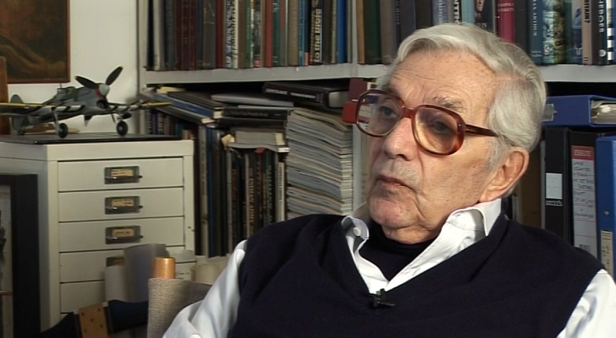NEXT STORY

Spending another year in Germany after the war
RELATED STORIES

NEXT STORY

Spending another year in Germany after the war
RELATED STORIES


|
Views | Duration | |
|---|---|---|---|
| 21. Pre-flight superstitions | 172 | 01:11 | |
| 22. The Falaise Gap: the smell of death | 276 | 03:40 | |
| 23. 'We used to miss a lot of targets' | 155 | 01:01 | |
| 24. Reunion at Duxford | 160 | 02:15 | |
| 25. Belsen concentration camp | 236 | 02:36 | |
| 26. Distractions from the heavy impact of the war | 149 | 01:05 | |
| 27. Everlasting bonds with fellow pilots | 186 | 02:55 | |
| 28. Bailing out: 'We didn't have ejector seats in those days' | 161 | 03:26 | |
| 29. Spending another year in Germany after the war | 256 | 01:01 | |
| 30. Riverside Studios: how I got started in film | 186 | 02:11 |


The problem, of course, was we didn't have ejector seats in those days, and if you… baling out of a plane was not that easy, because... in a single-seater... because you had to turn the plane on its back, jettison the hood, and try and kick… undo your straps... try and kick the control column forward so that you were really like catapulted out of the plane. And the reason for that was because a number of pilots got hit by the tailplane, and of course they were... So… and you know, you could never learn that on the ground, there was no way of practising it, but that was a way to try… and then the other thing which is also sad, because I remember on one show when we lost quite a number of pilots, one of the first ones was a stupid thing. We had to attack a radar station at Bruneval near Le Havre, and we lost, in my squadron alone, two pilots, and one a Belgian whom we called Junior, had baled out successfully. And I was the last man in and I sort of circled round, giving 'Maydays' to… and I never saw him come out from underneath the parachute because, you know, what you ideally should have done is when you were about 50 ft or 40 ft above the sea, is to release yourself from the parachute and drop into the sea. But of course the danger also was that if the sea was calm, you misjudged your height, you might have released yourself at 300 or 400 ft, and so on, but... Junior, this young Belgian pilot, we never found. So even... baling out you had to think of all these things, you know. It's all right if you have a pretty rough sea, you can judge more or less how high you are, but sometimes the sea was very flat and very calm, and you can't judge. And, you know, the parachutes in those days were enormous, you know. It was like... I don't know, but I used to do a lot of boating... have you ever been under a sail when you go…? It's not a very nice feeling, you know.
Sir Kenneth Adam (1921-2016), OBE, born Klaus Hugo Adam, was a production designer famous for his set designs for the James Bond films of the 1960s and 1970s. Initially, he trained as an architect in London, but in October 1943, he became one of only two German-born fighter pilots to fly with the RAF in wartime. He joined 609 Squadron where he flew the Hawker Typhoon fighter bomber. After the war, he entered the film industry, initially as a draughtsman on This Was a Woman. His portfolio of work includes Barry Lyndon and The Madness of King George; he won an Oscar for both films. Having a close relationship with Stanley Kubrick, he also designed the set for the iconic war room in Dr Strangelove. Sir Ken Adam was knighted by Queen Elizabeth II in 2003.
Title: Bailing out: 'We didn't have ejector seats in those days'
Listeners: Christopher Sykes
Christopher Sykes is an independent documentary producer who has made a number of films about science and scientists for BBC TV, Channel Four, and PBS.
Tags: Le Havre, Saint-Jouin-Bruneval, World War II
Duration: 3 minutes, 26 seconds
Date story recorded: December 2010 and January 2011
Date story went live: 15 August 2011